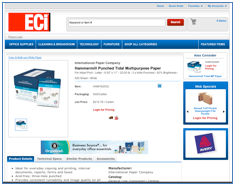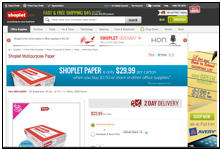Part of being in the consulting business means paying attention to different content feeds and participating in today’s marketing world, including social media. This showed up last week:

The continuing shift of users from PCs to tablets and smartphones is a trend that will not stop. Mobile is growing more and more important every day.
If you buy into the premise that your company needs to embrace the mobile transformation, keep on reading. If you don’t buy into the premise – well, good luck. Just so we’re all on the same page, the following is an attempt to level set our understanding of what “mobile ready” means. In a nutshell, there are three ways you can address eCommerce given the different devices accessing the Internet today. These methods are:
 Responsive Web
Responsive Web

The premise here is that your web is device and resolution agnostic. Basically, your site will scale properly to the device that is using it. The same code and pages are used for any device that navigates to your website. As of today, this probably describes your site. The good news is that your users can stretch and compact the screen where necessary. That’s also the bad news – this deviates from creating a great user experience and single click ordering. Quite honestly, this is what the majority of our software providers are providing. The screen shots show the leading software provider’s experience on the PC versus mobile. While usable, the experience is not optimized for the mobile device or user.
Mobile Website

 The mobile website has
different code and page design to create an improved user experience for the
device accessing the site. This is a
more expensive approach as a lot of thought needs to be invested in creating a
great user interface. The positive news
is that the hard-core mobile user gets an interface they like and one that
they’ll use. The Shoplet screenshots
show the difference between a product display on a PC and an iPhone. Note that the page name on the iPhone begins
with m – the mobile page view. One quick
point – you’ll notice that the web page displayed on PCs requires scrolling to
see pertinent information. The fact that
Shoplet is considered on of the “best-practices” sites in our industry requires
multiple touches to see product information is, well, interesting . . .
The mobile website has
different code and page design to create an improved user experience for the
device accessing the site. This is a
more expensive approach as a lot of thought needs to be invested in creating a
great user interface. The positive news
is that the hard-core mobile user gets an interface they like and one that
they’ll use. The Shoplet screenshots
show the difference between a product display on a PC and an iPhone. Note that the page name on the iPhone begins
with m – the mobile page view. One quick
point – you’ll notice that the web page displayed on PCs requires scrolling to
see pertinent information. The fact that
Shoplet is considered on of the “best-practices” sites in our industry requires
multiple touches to see product information is, well, interesting . . .
Native App
A native app is written for the specific device that it is running on – ie, an iPhone or an Android device. Typically these apps can be downloaded from “app stores” like Google Play or IOS app store. The advantage to this approach is a business can extend their brand and take advantage of specific hardware capabilities – cameras for bar code reading as an example. The disadvantage is that this is a very expensive approach. For the vast majority of distributors in a non-B2C environment, this is not an attractive approach.
So now that this is all crystal clear – how does your company deploy the right mobile strategy? The reality is the vast majority of distributors today are tied to their system provider and their technical offerings. In our industry eCommerce is so tightly integrated with our back office systems that we can’t modify our eCommerce offering without lining up our system provider(s). So what can you do?
Software Provider Strategy
I’ve discussed mobile readiness with several software executives in our channel – some in the systems business and some in the mobile business. Everyone gets it – I believe the big miss is that we’re moving too slow and some smaller providers don’t sense the urgency. The feeling is that mobile is really a B2C concern – why would someone in an office environment be using his or her smartphone to order product? I hope that the prior two discussions addressing the shift in Internet platforms gives YOU the ability to have a deep discussion with anyone that thinks mobile is not important.
So how do we get your software provider engaged?
Influence their plans
I’ve been in this industry for a long time – the 3PVs in this marketplace will listen to what your consumers are asking for. While in the past you may have been getting lip service, times have changed. Attend industry meetings and continue to drive this point home. If your eCommerce vehicle becomes irrelevant, you lose, the software provider loses, and the independent dealer community loses.
Join or build user groups
I can hear your response already – I have a business to run and don’t have time to network. Now that you said it out loud you understand that’s a lousy excuse. Talk to your peers and put together something that is more than a loose group of like-minded businesses. Organize and prioritize your needs and partner with your software provider to create a plan – and put in place the means to track the execution of progress. Your provider will listen to any organized group presenting their view of development priorities. However, the following may factor into that discussion . . .
Funding
Ouch – NOT one of my favorite topics. How this desired functionality would be funded is a valid discussion. The capitalization of the different software providers varies widely. Some providers have this in their budget already and should be willing to share their plans – and they should do that sooner rather than later. Others are going to need some capital to make this work. It is in your interest to explore this issue with your peers and your provider. Quite honestly, this is an investment that MUST be made – find a way to make it happen. If there is no clear path then . . .
Find a new system
If all of the previous options don’t work for you then perhaps it is time to explore options. I’m going to state the obvious – if your eCommerce vehicle becomes irrelevant or unusable as demographics shift and ordering methods transform, your business will suffer. And any additional suffering in a tough business environment may be the straw that breaks the camel’s back. There are lots of reasons to explore new systems – driving new technology is very important.
Whew. If you’re still reading at this point I’m impressed. This is a very important subject and something we collectively need to get our arms around. If nothing else, I hope that this fuels some conversations internally at your company and more importantly with your network of peers.
If you feel that AOPD can be of assistance to you in any of these endeavors, please reach out to any of us and share your thoughts. Technology is challenging and difficult to keep up with – especially at the speed things are changing today. However – if you keep it high on your radar, partner with the right businesses, technology can be a differentiator for you and drive expanded opportunities and new business. Embrace the challenge.
![]() Let me know how your
business is addressing the mobile shift – I’d enjoy sharing any success stories
you may be having. If you have any
questions or comments, please feel free to contact me via email at tj@aopd.com, or by phone at 714-692-9570.
Let me know how your
business is addressing the mobile shift – I’d enjoy sharing any success stories
you may be having. If you have any
questions or comments, please feel free to contact me via email at tj@aopd.com, or by phone at 714-692-9570.
